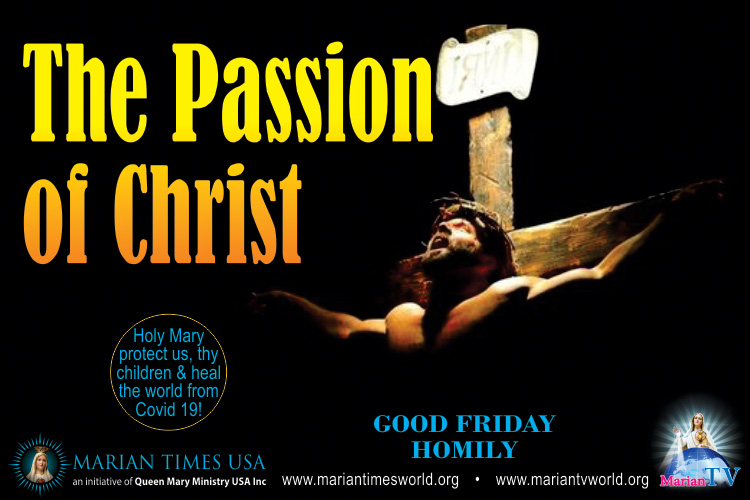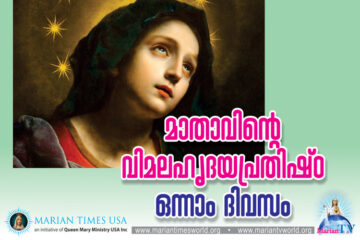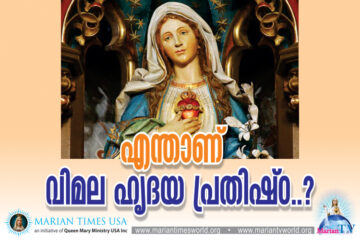The Passion of Christ – Good Friday Homily


~ Fr. Abraham Mutholath ~
Chicago, USA. ~
GOOD FRIDAY
The Passion of Christ.
INTRODUCTION
The passion of Christ, from his agony in the garden to his death, was the most torturous suffering a person could undergo. Jesus fulfilled his words, “Son of Man did not come to be served, but to serve, and to give his life as a ransom for many.” (Mark 10:45). Jesus and his mother Mary fulfilled God’s promise of the woman and her son who would destroy the serpent that led to the fall of mankind. When Jesus successfully accomplished his mission on the cross, he drank the fourth cup of Passover and said, “It is finished.” It was not words of relief but words of accomplishment like the words of a military captain saying at completion of a victorious war. Let us join Jesus in carrying our crosses and finally say with him, “Father, into your hands I commend my spirit” (Luke 23:46).
Interpretation
The sequence of events during the Passion of Christ according to the gospels is as follows:
- The Agony in the Garden
- The Betrayal and Arrest of Jesus
- The Inquiry before Annas
- Peter’s Denial of Jesus
- Jesus Before the Sanhedrin
- Jesus Before Pilate
- Jesus Before Herod
- The Death of Judas
- The Sentence of Death
- Mockery by the Soldiers
- The Way of the Cross
- The Crucifixion
- The Death of Jesus
- The Burial of Jesus
The Agony in the Garden. (Matthew 26:36-46, Mark 14:32-42, Luke 22:39-46)
Comfort from the Father alone
After the celebration of Passover, Jesus went with the eleven apostles to the Mount of Olives to pray and gain spiritual strength before his passion. There was no garden in Jerusalem because of space limitation on the Temple mountain. Gardens owned by private persons were available on the Mount of Olives. The owner of the Garden of Gethsemane might have given permission for Jesus to use it for night prayers. When Jesus and companions reached the garden, Jesus took only Peter, James, and John closer to him where he prayed. These three were so dear to him that they were with him on special occasions like raising to life the daughter of Jairus (Mark 5:37) and the transfiguration of Jesus (Mark 9:2). Even though Jesus requested them thrice, “My soul is sorrowful even to death. Remain here and keep watch with me.” (Matthew 26:38), they failed and fell asleep. The triple request was a sign of how fervent he needed their support at that time. So, in the great distress, Jesus was left alone.
During the time of anguish, the presence of the dear ones is a relief. When all deserted Jesus, he gained strength from his Father because the Father sent an angel from heaven to strengthen him(Luke 22:43). “Even if my father and mother forsake me, the LORD will take me in.”(Psalm 27:10). Let us never forsake our faith in God, so we have always the companionship and comfort from God in our distress and solitude.
Subjecting to the Father’s Will
Jesus prayed: “Abba, Father, all things are possible to you. Take this cup away from me, but not what I will but what you will.” (Mark 14:36). He earnestly presented this prayer three times expressing his nervousness because he knew how torturous was his martyrdom going to be. His address of “my father” or “Abba” was an expression of his filial intimacy with God. “This cup” stood for the fourth cup of the Passover that Jesus substituted for his crucifixion. In the Lord’s prayer Jesus taught us to pray to the father, “your kingdom come, your will be done, on earth as in heaven.” (Matthew 6:10). So, every time he repeated the prayer request, he concluded saying, “not as I will, but as you will.”
Let our prayers also be expressing our willingness to accept the will of God. Isaac was the prototype of Jesus. Isaac is believed to be in his thirties like Jesus when his father Abraham took him to sacrifice on Mount Moriah where Jesus was sacrificed later. Isaac could easily escape from the sacrifice by overtaking his aged father. However, he willingly subjected himself to his father for sacrifice. Though God saved Isaac’s life, He wanted His son Jesus to fulfill the mission and strengthened him by sending an angel showing the heavenly presence and support.
- The Betrayal and Arrest of Jesus.(Matthew 26:47-56, Mark 14:43-52, Luke 22:47-53, John 18:1-14)
Kiss of love altered to kiss of betrayal
Judas was attracted to Jesus who gave him the privileged position to be an apostle. He was even entrusted with the little money Jesus and his disciples received for their sustenance from the well-wishers. Unfortunately, his interest shifted from Jesus to money.
Mismanagement of wealth or greed for money has been causing the downfall of many people and their relationship with others and with God throughout history. God might entrust more than needed wealth to some people not just for their enjoyment but to test them whether they share it with others. Let us remember that faith in Jesus and practice of what he taught are our treasure in this world and in heaven.
Peter, a brave defender
Peter was quick in action. He struck Malchus, the high priest’s slave, with a sword and cut off his right ear. Even at the time of his arrest, Jesus was compassionate to touch and heal Malchus (Luke 22:51).
Christianity and church assets are to be defended by love and not by war. Oftentimes, our quick response in times of crisis is to take sword like Peter. Self-acceptance of failure in this world was the gateway of glory to Jesus who set that as an example for us.
3.The Inquiry before Annas. (John 18:19-24)
John the Evangelist reports that Jesus was brought in front of Annas the former high priest and father-in-law of Caiaphas, the then high priest. Annas was a corrupt person and had bribed the Romans to get the position of high priesthood. He had business alliance with the merchants who were money changers and sellers of sacrificial animals in the temple area. Since excessive exploitation was taking place in the name of God at the holy place, Jesus had wiped out the businessmen. That ignited the fury of Annas against Jesus and caused the arrest of Jesus.
Jesus questioned the trial of Annas because he was violating the Jewish procedure of trial. The accusers were supposed to bring two independent witnesses against the accused. The judge was not supposed to ask leading questions to the accused. When Jesus questioned these to Annas, the temple guard struck Jesus. Jesus questioned that also, because he was right in answering.
We might also face challenging situations and false accusations even when we are right. Jesus showed how we can defend ourselves. We don’t have to agree with the falsehood.
- Peter’s Denial of Jesus. (Matthew 26:69-75, Mark 14:66-72, Luke 22:54-65, John 18:15-18, 25-27)
Peter went to the courtyard of Caiaphas, the high priest, while Jesus was under trail. This was with the help of another disciple who accompanied him to witness the trail of Jesus. According to scholars, that could probably be John the Evangelist, who accompanied Jesus and Mary to Calvary. John’s father Zebedee had fresh and salted fish business. He used to sell salted fish to the High Priest’s palace and John might have been delivering that before he followed Jesus. That might have helped John to get some influence with the staff of the high priest’s palace.
Peter’s denial of Jesus three times was to fulfill what Jesus had told him before. It was not as grave as what Judas did. Peter was enthusiastic to defend Jesus by striking with sword the high priest’s servant and to accompany Jesus during his trial. No one else in the company of Jesus was bold enough to do those, except John who also loved the Lord passionately. Peter’s denial of his companionship with Jesus was necessitated to protect his life to lead the church later. St. Luke reports that Peter “went out and began to weep bitterly.” (Luke 22:62).
Mistakes happen even when we ardently follow Jesus. Repentance is the best remedy and God cannot ignore a repentant soul.
- Jesus Before the Sanhedrin. (Matthew 26:57-68, Mark 14:53-65, Luke 22:66-71)
According to the Jewish law and traditions, there were many violations in the trial of Jesus.
(1) Trial at night was illegal:The Jewish trial of Jesus was illegitimatelydone at night in front of the high priests and probably their favorable members in the Sanhedrin. Caiaphas was the official high priest during the trial of Jesus. Annas, who was the former high priest and father-in-law of Caiaphas, was the president of Sanhedrin. Though Sanhedrin was not supposed to meet at night, the high priests went out of the way to meet the Sanhedrin at that time because they were in a hurry to crucify Jesus.
(2) The location of the trail was wrong:The Sanhedrin met for the trial of Jesus at the high priest’s house (Matthew 26:58), instead of one of the chambers of the inner court of the Temple. The death sentence had to be passed near the altar to assure that justice was guaranteed, and the decision was acceptable to God.
(3) The Sanhedrin was prejudiced and had only false witnesses: Most members of the Sanhedrin had in mind capital punishment for Jesus before the trial. They were struggling to get enough proof for their false accusations against Jesus. They were unsuccessful in getting two witnesses that would agree in testimony. When the false witnesses failed, “’the high priest asked him and said to him, ‘Are you the Messiah, the son of the Blessed One?’ Then Jesus answered, ‘I am; and you will see the Son of Man seated at the right hand of the Power and coming with the clouds of heaven.’” (Mark 14:61-62). Only based on this statement of Jesus, the Sanhedrin accused blasphemy on Jesus. Such questioning of the culprit in the Sanhedrin was illegal.
(4) Crucifixion was not the punishment for blasphemy:The regular punishment for blasphemy was stoning to death (Leviticus 24:10-16). However, the Sanhedrin wanted the most painful crucifixion for Jesus. This was to fulfill the Old Testament symbol of bronze serpent raised on a pole for saving sinners’ lives and to fulfill Jesus’ prophecy that he would be exalted (John 3:14, 12:32–33). Hence, the judgment of crucifixion was false even if Jesus was guilty of blasphemy.
(5) Enough time was not taken for the judgment:A death sentence could not be pronounced within one day. The Sanhedrin was supposed to sleep over it one night and reconsider the decision before the sentence was finalized. This did not happen in Jesus’s case.
So, the time, place, procedure of the trial, and the punishment they wanted were all illegal. The hatred and prejudice can lead us to unjust decisions and judgment against others in the family or in the community. Like Jesus who came not to judge but to save, let us be saviors of others who are in trouble. The second coming of Christ will be only for judgment and reward for the righteous.
- Jesus Before Pilate. (Matthew 27:1-2, 11-14 Mark 15:1-5, Luke 23:1-5, John 18:28-38)
Though the accusation of Sanhedrin against Jesus was blasphemy, they did not bring up that to Pilate. Instead, the three accusations they presented against Jesus to Pilate were issues of concern for the Roman authorities: “We found this man misleading our people; he opposes the payment of taxes to Caesar and maintains that he is the Messiah, a king.” (Luke 23:2). Pilate did not find any truth in these nor any serious offense for a severe punishment as crucifixion. The accusation that Jesus claimed himself to be the king of Jews could be considered as a treason against the Roman emperor and against the position of Pilate who was the governor replacing the king of Jews for the provinces of Judea, Samaria, and Idumaea. But, Pilate knew that Jesus was never a challenge to Rome or to him. When questioned, Jesus also clarified that his kingdom was not of this world. Pilate’s conclusion was that Jesus was not guilty. But he was not bold to free Jesus because of his selfish motives.
- Jesus Before Herod. (Luke 23:6-12)
Herod Antipas was the king in Galilee from 4 B.C. to 39 A.D. He had martyred John the Baptist. He came to Jerusalem for the Passover feast. Since Jesus was from Galilee, Pilate found an excuse from sentencing Jesus by sending him to his neighboring king and enemy, Herod. Herod also did not want to sentence Jesus in the territory of Pilate though he had previous plans to kill Jesus (Luke 13:31). Herod was curious to see Jesus and to see him perform some miracle. Though Jesus was mocked and persecuted by his soldiers, Jesus did not answer to any questions of King Herod. So, Herod sent Jesus back to Pilate.
The curiosity to understand Jesus won’t save a person. Faith in Jesus and following his teachings are needed for salvation. Because of the referral of Jesus for trial to one another, Pilate and Herod who had been enemies became friends.
- The Death of Judas. (Matthew 27:3-10)
The brothers of Joseph had sold him to Midianite merchants who were going to Egypt for 20 shekels of silver. History repeated in the case of Jesus when Judas sold him for 30 pieces of silver which was the price of a slave. When Judas realized that Jesus had been condemned, he regretted deeply on what he had done (Matthew 27:3). He might have assumed that Jesus would escape from the enemies as he had done several other occasions. However, Jesus’s time had arrived. Judas’ attempt to return the money to the chief priests and elders did not help to release Jesus. The Satan that entered Judas did not allow him to turn towards his master for forgiveness. His depression was so deep that he committed suicide. Even the Temple authorities found that it was unlawful to deposit the money in the Temple treasury. So, they bought a potter’s field as a burial place for foreigners.
If we delay in turning back to Jesus for forgiveness and change of life, there might come a time of no return. Judas had been warned by Jesus, but he had failed to correct himself. As humans, we might fail and ignore God given warnings. Like Peter, let us find relief in Jesus and compensate our mistakes by our commitment to God.
- The Sentence of Death. (Matthew 27: 15-26, Mark 15:6-15, Luke 23:18-25, John 18:39-40, 19:1-16)
When Jesus was brought back from Herod to Pilate, he had to make a tough decision. He was in conflict between justice and pressure tactics of chief priests and elders. He also had a message from his wife: “Have nothing to do with that righteous man. I suffered much in a dream today because of him.” (Matthew 27:19). Pilate tried to find excuses to avoid the crucifixion for Jesus.
Pilate’s tactics to release Jesus
Pilate thought of releasing Jesus as the person to be freed during the Feast of Passover. But that selection was not entrusted with him but to the choice of the people (Matthew 27:15).He presented an option to the public between Jesus and a notorious criminal Barabbas who committed murder in a rebellion. People after comparing them urderer and God, under the influence of chief priests and elders (Matthew 27:20),who were mediators between God and humans, selected a criminal to be freed and the innocent Lamb of God to be sacrificed.
The next tactic of Pilate was to scourge Jesus and present him in a sympathetic shape to satisfy his enemies and make them allow his release. The soldiers of Pilate scourged Jesus probably 39 times as per practice of the time, hard-pressed a crown of thorns on his head, clothed him in a purple cloak, and struck him repeatedly mocking him as the “King of the Jews.” However, the enemies repeated saying, “Crucify him!”
Pressure tactics of Jews
When Pilate attempted to release Jesus, the Jews used their pressure tactic saying, “If you release him, you are not a Friend of Caesar. Everyone who makes himself a king opposes Caesar.” (John 19:12). Jews hated Pilate because they had previous issues with Pilate and had complained against him to the Roman emperor. When Governor Pilate first visited Jerusalem from Caesarea, which was his headquarters, he came with soldiers who carried the image of the emperor on their standards that were used instead of flags. All the previous Roman governors had removed the image before they entered the city to respect the faith of the Jews. Despite the demand of the Jews, Pilate was adamant on his decision. The Jews followed Pilate to Caesarea. Pilate threatened to kill the large gathering of Jews. They were even willing to die for their belief. To avoid a massacre of the Jewish gathering, Pilate had to agree with them.
The second issue Pilate had with Jews was that he raided the Temple treasury to meet the expenses of a new aqueduct he reconstructed to supply enough water to Jerusalem. It had benefitted the Temple that needed much water for the sacrifices and cleaning. However, Jews objected taking money from the Temple treasury and they made riots on the street. Pilate mingled his soldiers in civil clothes with the rioters and at a given signal attacked and killed many of them. Because of the complaint of Jews, Pilate had to answer to Roman Emperor Tiberius for his action.
A third incident was that when Pilate was in Jerusalem, he used to stay in the ancient palace of Herod. He had made shields with the name of the emperor inscribed on them. Since emperor was regarded as god in the Roman empire, and that name was inscribed and displayed for reverence in the Holy City, the Jews vehemently objected. Pilate refused to remove it. At the request of the Jews, Emperor Tiberius asked Pilate to remove it. Thus, Pilate had many downfalls in his relationship with the Jews. So, he knew that release of Jesus could be another setback for him from the Jews who would complain to the emperor against him.
Pilate, who was bold in many previous occasions, found it better to be free from trouble and look for his bright future. He ignored the warning he received through the dream of his wife. Sometimes, we also fall into the situation of Pilate. Our past might haunt us and prevent us from doing the right. Our concern for the worldly future also might influence us to do injustice.
Pilate washing hands
Pilate was sure that Jesus was innocent. His conscience was bothering him also because his wife sent him message about the innocence of Jesus. At the same time, he had to avoid trouble from Jews and from the Roman emperor. So, he used a Jewish custom of washing hands to escape from the murder of an innocent person as given in Deuteronomy 21:1-9. Still Pilate was doing injustice as a judge. He judged to crucify the innocent one who will come one day as the judge of Pilate and all humanity.
Two mistakes of Jews
When Pilate asked, “Shall I crucify your king?” The chief priests answered, “We have no king but Caesar.” This was a clear denial of God as their king (1Samuel 12:12), (Judges 8:23) accepting the Roman emperor instead. Hatred of humans can lead to denial of God because we cannot accept and love God by hating and maltreating others.
The second mistake of Jews was that when Pilate could not succeed in convincing the Jews to release Jesus and they were at the verge of rioting, Pilate washed his hands in public and said, “I am innocent of this man’s blood. The responsibility is yours!” The whole people replied, “His blood be upon us and upon our children.” (Matthew 27:24-25).
Blood of Jesus stands for his life and sacrifice. Itwas shed for the forgiveness of the sins of all humanity. However, the whole crowd gathered at the trial of Jesus were so much taken up by the influence of the Sanhedrin that they, out of their emotion, took up the curse of the innocent blood on them and their future generations. It was a Jewish belief that the guilt of innocent blood shall fall upon the false witnesses and their children to the end of the world. Some interpreters view the fall of Jerusalem after 40 years in 70 A.D., the destruction of the Temple and its sacrifices, and centuries of exile and dispersion of the Jews wereresults of the above pledge they made. Catholic Church do not hold this view. According to the Second Vatican Council, guilt for Jesus’ death is not attributable to all the Jews of his time or to any Jews of later times.
- Mockery by the Soldiers. (Matthew 27:27-31, Mark 15:16-20, John 19:1-5)
Scourging was a normal part of the crucifixion penalty. The soldiers were Romans and not Jews. They might have arrived from Caesarea Maritima on the Mediterranean coast along with Pilate. Since they heard that Jesus was accused of claiming to be the king of Jews, they mocked him as if he was a lunatic.
The scourging and mockery were physically and mentally torturing. The soldiers took Jesus to the praetorium which was the old palace of Herod and the temporary residence of the Roman governor when he visited Jerusalem. Pilot used to go to Jerusalem during the great feasts to assure prevention of any nationalistic riot against Rome during the enormous gatherings of Jewish pilgrims. Matthew records that he whole cohort gathered around Jesus. (Matthew 27:27). The cohort was normally six hundred soldiers. They stripped off Jesus’ clothes and dressed him with a royal purple cloth. They weaved a crown out of long straight thorns and placed on his head as a crown, gave a reed in his right hand, spat on him, took the reed and kept striking on his head. This was the fulfillment of what Isaiah said in 50:6 “I gave my back to those who beat me, my cheeks to those who tore out my beard; My face I did not hide from insults and spitting.” Once done with mocking and torturing, they stripped him of the cloak and dressed in his own clothes and led him for crucifixion. They in fact adorned with royal attire, the real king of the universe, though Jesus never dressed up like that because his kingdom is not of this world.
When we suffer for justice and for Jesus, our suffering will be an honor and a norm for reward in front of God. Jesus told his disciples, “Blessed are they who are persecuted for the sake of righteousness, for theirs is the kingdom of heaven. Blessed are you when they insult you and persecute you and utter every kind of evil against you [falsely] because of me. Rejoice and be glad, for your reward will be great in heaven. Thus they persecuted the prophets who were before you.” (Matthew 5:10-12).
- The Way of the Cross. (Matthew 27:32, Mark 15:21, Luke 23:26-32)
Out of the 14 stations of the cross that we do as a devotion, the three falls of Jesus, Jesus meeting his mother Mary, and Veronica wiping the face of Jesus are not specifically documented in the Bible. The meeting of Mary on the way of the cross might have happened because she was at the foot of the cross. That meeting might have been heartbreaking for Mary though she knew that he was fulfilling his mission. Mary is a great role model for mothers sending their children to missions.
Veronica wiping the face of Jesus
The story of Veronica wiping the face of Jesus on the way to Calvary is not documented in the Bible. Her story appeared in a book called “Acts of Pilate” where Veronica is identified as the woman who had been suffering hemorrhages for twelve years. She came up behind Jesus and touched his tassel on his cloak and got cured (Matthew 9:20-22). The story also tells that Jesus left an image of his face on the cloth that she used to wipe his face. The rest of the story is that Veronica “went to Rome and cured the Emperor Tiberius by showing him a painting she had made of Christ after her own healing.”
Simon helping Jesus to carry the cross
Roman soldiers had a practice to forcefully ask anyone on the road to help them carry their luggage. It was in this context that Jesus taught, “If a soldier demands that you carry his gear for a mile, carry it two miles.” (Matthew 5:41). While Jesus was carrying the cross to Calvary, the soldiers forced Simon, a Cyrenian to carry the cross so that Jesus could be crucified alive. Cyrenaica was the capital of a Roman province on the north coast of Africa. and Cyrene was its capital city. The city had a large population of Greek-speaking Jews. Simon, a Greek-speaking Jew might have migrated to Palestine. “After laying the cross on him, they made him carry it behind Jesus.”(Luke 23:26). Simon was literally fulfilling the teaching of Jesus, “Whoever wants to be my disciple must deny themselves and take up their cross and follow me.” (Matthew 16:24). Simon was in fact carrying the cross of Jesus and following him. Jesus wants us to share his cross in our lifetime to continue his mission in this world.
Mark 15:21 presents Simon as “father of Alexander and Rufus.” The reason for giving the names of his sons are because they must have been prominent followers of Jesus and well-known leaders of the early church. It is not just curses that pass down to generations, but blessings as well. The good works we do for Jesus and his church will have its lasting effects in our coming generations.
Women devotees pacifying Jesus
While the soldiers and many bystanders on the roadside were looking at Jesus with contempt, “A large crowd of people followed Jesus, including many women who mourned and lamented him.” (Luke 23:27). As a human, their support must have been a comfort for Jesus. He still used the occasion to advise them of the care to be taken to face future tribulations that were going to happen to them and to their children. Concern of Jesus was true, and the tribulation happened in 70 A.D. when the followers of Jesus escaped it while a huge number of Jews were killed, many taken as slaves to Rome, and City of Jerusalem along with the Temple was destroyed.
Our Passion Friday message from Jesus is the same that Jesus gave to these devoted women. Let us be concerned about the spiritual wellbeing of us and our future generations even amid tribulations of this world.
- The Crucifixion. (Matthew 27:33-44, Mark 15:22-32, Luke 23:33-43, John 19:17-27)
The Place of Skull
Jesus was crucified on Golgotha which means “Place of Skull.” There are different interpretations to this place. (1) It was a rock with skull-shaped appearance. (2) There was heap of skulls from many people who were crucified there and were not buried. The Jews used to bury the dead bodies. But Romans let the dead body to be eaten by animals and birds. So, it was a place of bones and skulls.
(3) Traditional belief was that Adam’s skull was buried at Golgotha. According to Jewish tradition, Noah confided the skull of Adam to his son Shem who later did the same to Melchizedek. The skull was finally deposited at the mountain that came to be known as Golgotha because of the skull of Adam. Some early Christian writings also give similar accounts. That is why the skull of Adam is depicted at the foot of Christ’s cross to show that Adam’s sin was compensated by the blood that fell on the skull of Adam from the crucified body of Jesus. This was the fulfillment of God’s promise to Adam that he would send a redeemer (Genesis 3:15).
(4) Some scholars associate Golgotha with Mount Moriah. Mount Moriah was the place that God showed Abraham to sacrifice his son Isaac (Genesis 22:2). Solomon built the Temple at the same place (2 Chronicles 3:1) and came to be known as Temple Mount. Later Herod’s temple was built at the same location. Golgotha has the same height of the Temple Mount and both are facing each other at distance of only 300 meters. Jesus was the Lamb that Abraham told his son, “God himself will provide the lamb for the burnt offering, my son.” (Genesis 22:8).
Wine mixed with gall
Jesus was offered a narcotic, “wine drugged with myrrh” to drink. The wealthy and compassionate women in Jerusalem used to give such a narcotic to those who were going to be crucified to soothe their bitter pain during crucifixion. But Jesus declined it so that he could endure the full suffering for humanity. This is also a fulfillment of Psalm 69:22.
Forgiving enemies
While suffering on the cross, Jesus said, “Father, forgive them, they know not what they do.” (Luke 23:34). Jesus might have included all who were instrumental in his horrific torture. Thus, Jesus became a role model for us in dealing with our enemies. Many early Christian martyrs also imitated Jesus by praying for their persecutors during their martyrdom.
Soldiers divided his garments
The criminal to be crucified was led to execution in the middle of a square of four soldiers. Since criminals were crucified naked except for a loin of cloth, the four soldiers divided the garments of the criminals. There were five articles of clothing worn by a Jew: shoes, turban, girdle, inner garment and outer cloak. “When the soldiers had crucified Jesus, they took his clothes and divided them into four shares, a share for each soldier. They also took his tunic, but the tunic was seamless, woven in one piece from the top down.” (John 19:23). Only the high priest was using such a garment woven in one piece. Dress of Jesus was believed to be woven by his mother and gave him when he started his public ministry. She made it like the dress of a high priest because she knew that he was the high priest going to offer sacrifice for the atonement of the sins of the world. The soldiers did not tear it but cast lots for it. This was the fulfillment of Psalm 22: 19, “they divide my garments among them; for my clothing they cast lots.”
Jesus the Nazarian, the King of Jews
The offense of a person condemned to death by crucifixion was written on a tablet that was displayed on the way of the cross and nailed on the cross. Since the execution was done by Romans, Jews had no control on this. The charge against Jesus was that he had claimed to be the King of the Jews. However, Pilate purposefully wrote: “Jesus the Nazorean, the King of the Jews.” The inscriptions were in Hebrew, Latin, and Greek. In Latin it was, Iesus Nazarenus Rex Iudaeorum (INRI). That is why this acronym is written on the crucifix. Chief priests requested Pilate to change it as, “He said, I am the King of Jews.” But Pilate did not change it affirming from his part that Jesus was their spiritual king.
Two Revolutionaries crucified on the sides of Jesus
Two revolutionaries were crucified on both sides of the true revolutionary of God’s love, Jesus. During the time of the public ministry of Jesus, there were Jewish revolutionaries like Barabbas who fought against the Roman rule. Jesus’ crucifixion amid two wicked men was the fulfillment of Isaiah 53:12, “he exposed himself to death. He was counted among the rebels. He bore the sins of many and interceded for rebels.”
Bible does not give the names of the two rebels. However, they are known as Dismas and Gestasbased on a non-canonical book, “The Gospel of Nicodemus” written in the fourth century. Dismas was considered as the good thief who asked Jesus to remember him in Christ’s kingdom” and to which Jesus replied, “Amen, I say to you, today you will be with me in Paradise.” (Luke 23:42-43). Gestashad asked Jesus, “Are you not the Messiah? Save yourself and us.” (Luke 23:39). The Catholic Church considers Dismas as a saint and celebrates his feast on March 25th.
Mockery by the public
Many people humiliated Jesus by insulting words while he was going through terrible pain on the cross. The people who did this were those passing by, those stood at the cross, the chief priests, the scribes, elders, those who were crucified with him, the rulers, and the soldiers. They were also tempting him saying like Satan at the temptation when Jesus started his public ministry, “If you are the Son of God …” (Matthew 3:4-6). When we are struggling in the work of God, there might be people who try to pull us back from our mission.
Entrusting Mother to John
God’s words to the serpent, along with the hope for the first parents stating, “I will put enmity between you and the woman, and between your offspring and hers; They will strike at your head, while you strike at their heel” (Genesis 3:15) was coming to realization at the foot of the cross where Mary, the Mother of God was as acting as a co-redeemer. That was the reason he addressed his mother, “woman.” Mary was a widow at that time and was going to be without a son to support. Jesus felt confidence in entrusting her care to his most beloved disciple, John. John whole-heartedly accepted her as his mother and took care of her until her death, along with his busy evangelization ministry. Jesus blessed John with long life and, according to tradition, rescued him from an attempt to kill him in boiled oil while he was in Rome. Jesus kept the commandment of God, “Honor your father and your mother.” (Genesis 20:12). Let us continue honoring our parents whether living or deceased.
- The Death of Jesus. (Matthew 27:45-56, Mark 15:33-41, Luke 23:44-49, John 19:28-37)
Time of Crucifixion to Death
The Synoptic gospels followed the Jewish calculation of time; whereas John followed the Roman time that we also follow in the modern times. According to the modern timing, Jesus was taken to the high priest’s palace before 3:00 A.M. when the “cock crow.” (Mark 13:35).According to scholars, “cock crow” was the usage for an official siren at 3:00 A.M. for shift change of soldiers before which Peter denied Jesus three times. Rearing cock within Jerusalem was not permitted. Annas, Caiaphas and Sanhedrin finished questioning Jesus before 6:00 A.M. and presented to Pilate. Trial before Pilate and Herod, mocking by soldiers, and way to Calvary were finished by 9:00 A.M. Jesus was crucified around 9:00 A.M. and was on the cross for six hours from 9:00 A.M. to 3:00 P.M. The darkness was felt for three hours from noon to 3:00 P.M.
The Passover lambs were sacrificed from 3:00 P.M. to 5:00 P.M. in the Temple on the previous day of Jesus’ crucifixion (Mark 14:12, Luke 22:7). Jews had to take home the sacrificed Passover lamb from the Temple to celebrate the Passover meal. The time of crucifixion and death correspond to the daily Perpetual Sacrifice (Tamid) in the Temple at 9:00 A.M. and 3:00P.M. Along with an unblemished male lamb they used to offer flour and wine(Exodus 29:38-39, Numbers 28:1-8). This would represent the bread and wine we offer for Holy Mass which becomes the “Lamb of God”. During the Tamid sacrifice, people used to pray for redemption from their sins. So, timing of Jesus sacrifice, its beginning and end at 9:00 A.M. and 3:00 P.M., coincided with the Perpetual Temple sacrifice for the redemption of sins. The sacrifice of Jesus replaced the Tamid sacrifice in the Temple, especially with the destruction of the Temple in 70 A.D.
“Why have you forsaken me?”
The mental agony of Jesus on the cross combined with the physical pain made him cry out in a loud voice, “My God, my God, why have you forsaken me?” (Matthew 27:46, Mark 15:34). This was reflected centuries ago in Psalms 22:2, “My God, my God, why have you abandoned me?” When we are in great distress, we might feel to cry out the same. Still Jesus did not give up his trust in God and fulfilled his Father’s will.
Last Cup of Passover Wine
It was normal that those who were crucified, cry of hunger and thirst. John states, “aware that everything was now finished” Jesus said, “I thirst.” (John 19:28). “There was a vessel filled with common wine. So they put a sponge soaked in wine on a sprig of hyssop and put it up to his mouth. When Jesus had taken the wine, he said, ‘It is finished.’ And bowing his head, he handed over the spirit (John 19:29-30). It could mean that his Passover was finished with the fourth cup. Jesus said, “It is finished” also in the sense of fulfillment of a great task like a military commander used to say at the end of a victorious battle.
The crucifixion of Jesus was his unfinished fourth cup at the Last Supper. When all his suffering was coming to an end, to finish his Passover meal, Jesus expressed his thirst. Hyssop was a small plant used to dip in the basin containing the blood of the Pascal lamb and to apply the blood to the lintel and the two doorposts before Israelites left Egypt (Exodus 12:22).
Extraordinary events at the death of Jesus
Some unusual events were reported at the time of crucifixion of Jesus:
- Solar eclipse happened for three hours with darkness felt from noon to 3:00 P.M. (Mark 15:33, Luke 23:14).This was the fulfillment of Amos 8:9, “On that day – oracle of the Lord GOD – I will make the sun set at midday and in broad daylight cover the land with darkness.”
- The veil in the sanctuary of the Temple was torn in two from top to bottom (Matthew 27: 51).According to the design of God, two veils were there in the tabernacle and later in the Temple. The outer veil was at the entrance of the Holy Place and the inner one in front of the Holy of Holies (Exodus 26:31–36). Only the high priest could enter the Holy of Holies and that only on the Day of Atonement (Leviticus 16:1–18). The meaning of the sanctuary veil torn in two is that bythe self-sacrifice of Jesus who is the perfect High Priest, the heaven(Holy of Holies) is open for all who follow Jesus.
- There was earthquake and splitting of rocks. “Tombs were opened, and the bodies of many saints who had fallen asleep were raised.And coming forth from their tombs after his resurrection, they entered the holy city and appeared to many.” (Matthew 27:52-53). All these were indicative of the coming of the final or Messianic age.
The last words of Jesus were, “Father, into your hands I commend my spirit” (Luke 23:46). Only a person in communion with God could say that. Let this be our wish that at the last moment of our life we could say the same words.
Many were attracted to Jesus at the Cross
Jesus had told his disciples, “When I am lifted up from the earth, I will draw everyone to myself.”(John 12:32). That was realized even immediately after his crucifixion. “The centurion and the men with him who were keeping watch over Jesus feared greatly when they saw the earthquake and all that was happening, and they said, ‘Truly, this was the Son of God!’” (Matthew 27: 54). “When all the people who had gathered for this spectacle saw what had happened, they returned home beating their breasts.” (Luke 23:48). Jesus transformed the cross that was a symbol of sin and punishment a key to heaven. Let us use the cross of Jesus as our ladder to heaven and help others to use it.
Ladies witnessed the death of Jesus
Because of life threat for the male disciples of Jesus, they avoided appearing at the crucifixion of Jesus, except John who was supporting Mary, the mother of Jesus. However, ladies had nothing to fear because they were of low status in the society at that time and the Jews did not consider them as a threat to their religion. The synoptic gospel writers report that many women who followed Jesus from Galilee were looking from a distance at the crucifixion though they named only a few(Matthew 27:55, Mark 15:40-41). Luke reports that, “but all his acquaintances stood at a distance, including the women who had followed him from Galilee and saw these events.” (23:49). We participate in the Last Supper or Passover of Jesus and witness his sacrifice when we take part in the Holy Mass(Qurbana). Let us make it with holiness and devotion.
Bones of Jesus not broken
According to Roman custom of crucifixion, the culprit was left to die on the cross even at night. Jewish law was different: “If a man guilty of a capital offense is put to death and you hang him on a tree, his corpse shall not remain on the tree overnight.” (Deut. 21:22-23). Besides, the following day after the crucifixion of Jesus was a very special Sabbath of the Passover. Hence, Jews asked permission from Pilate to brake the legs of Jesus and the other two who were crucified with him. That would facilitate death because the crucified would not be able to raise their chest to breath and they would die fast because of suffocation. Jesus was already dead and so the soldiers did not break his legs. John presents this as a fulfillment of Numbers 9:12 that no bones of the Passover lamb shall be broken. This also is another confirmation of the symbolism of Jesus as the Lamb of God.
The Blood and Water.
The blood stands for the life of a person. Jesus shed even his last drop separating his body and blood as was done for the lamb sacrificed in the Temple. A soldier thrust a spear on the chest of Jesus to break his heart assuring that he was dead. The blood, from the heart along with the fluid of the pericardium that surrounds the heart, flowed down. John presents this as the fulfillment of the prophecy in Zechariah 12:10, “They will look upon him whom they have pierced.” The water stands for baptism and the blood for Holy Eucharist; both are the final gifts of Jesus for our salvation. Later he also gave us the Holy Spirit on the day of Pentecost. We receive these three as Sacraments of Initiation to take full membership in the Holy Catholic Church headed by Christ.
- The Burial of Jesus. (Matthew 27:57-61, Mark 15:42-47, Luke 23:50-56, John 19:38-42)
The Romans had no practice of burying the dead body of the crucified criminals. They would leave the bodies on the ground and let animals and birds eat them. The Jewish law demanded the burial of the body on the same day (Deut. 21:22-23). So, permission was needed from Pilate to bury the body of Jesus. Since Jesus was from Galilee and the disciples were hiding and could not afford to pay a fitting burial within few hours, two secret friends of Jesus, Joseph of Arimathea and Nicodemus boldly came forward with generous contributions. They were not supporting Jesus in public before, to keep their membership in the Sanhedrin and save their reputation among the Jewish leaders. Oftentimes, we fail to help a person in need when alive. However, the timely contributions of these two people are praiseworthy.
Joseph of Arimathea had contributed his own valuable tomb that no one had used. That could help to prove the resurrection of Jesus. If any remains of a dead body were found in the tomb after the resurrection of Jesus, that could have made doubts on his resurrection. The presence of Mary Magdalene and other ladies who came on the third day after Sabbath was a proof that they knew the tomb of Jesus and they found that same tomb empty when they had returned. “The women who had come from Galilee with him followed behind, and when they had seen the tomb and the way in which his body was laid in it.” (Luke 23:55). The assurance Pilate made through the centurion that Jesus was dead (Mark 15:44) was another proof that Jesus was dead and so his resurrection was not a reappearance after hiding from the public. All the gospel writers assure to give evidences that led to the death and resurrection of Jesus.
The passion and death of Jesus led to his resurrection and enthronement in heaven at the right side of his Father. He will come again to judge the world. In this interim period, we need to make use of our time and talents to work with Jesus for the salvation of all. Our hardships for the kingdom of God shall be lightened and rewarded when we carry them following the cross of Jesus.
മരിയന് ടൈംസിലെ ഇന്നത്തെ പ്രധാനപ്പെട്ട അപ്ഡേറ്റുകള് താഴെ ലഭിക്കുന്നതാണ്.









